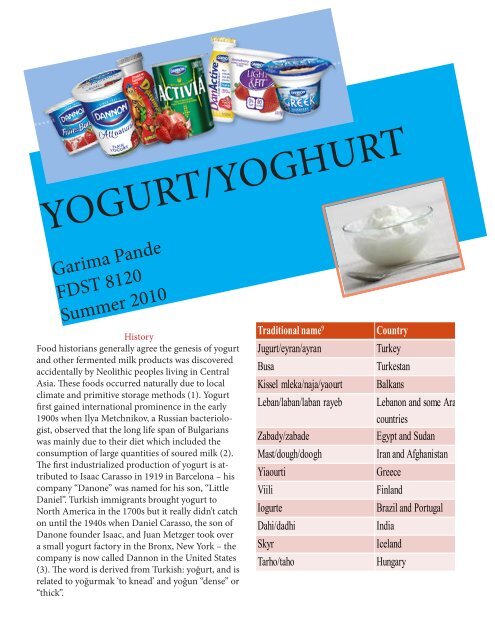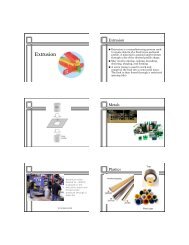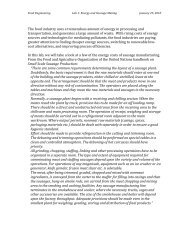YOGURT/YOGHURT
YOGURT/YOGHURT
YOGURT/YOGHURT
Create successful ePaper yourself
Turn your PDF publications into a flip-book with our unique Google optimized e-Paper software.
<strong>YOGURT</strong>/<strong>YOGHURT</strong><br />
Garima Pande<br />
FDST 8120<br />
Summer 2010<br />
History<br />
Food historians generally agree the genesis of yogurt<br />
and other fermented milk products was discovered<br />
accidentally by Neolithic peoples living in Central<br />
Asia. These foods occurred naturally due to local<br />
climate and primitive storage methods (1). Yogurt<br />
first gained international prominence in the early<br />
1900s when Ilya Metchnikov, a Russian bacteriologist,<br />
observed that the long life span of Bulgarians<br />
was mainly due to their diet which included the<br />
consumption of large quantities of soured milk (2).<br />
The first industrialized production of yogurt is attributed<br />
to Isaac Carasso in 1919 in Barcelona – his<br />
company “Danone” was named for his son, “Little<br />
Daniel”. Turkish immigrants brought yogurt to<br />
North America in the 1700s but it really didn’t catch<br />
on until the 1940s when Daniel Carasso, the son of<br />
Danone founder Isaac, and Juan Metzger took over<br />
a small yogurt factory in the Bronx, New York – the<br />
company is now called Dannon in the United States<br />
(3). The word is derived from Turkish: yoğurt, and is<br />
related to yoğurmak ‘to knead’ and yoğun “dense” or<br />
“thick”.<br />
Traditional name 9<br />
Jugurt/eyran/ayran<br />
Busa<br />
Kissel mleka/naja/yaourt<br />
Leban/laban/laban rayeb<br />
Zabady/zabade<br />
Mast/dough/doogh<br />
Yiaourti<br />
Viili<br />
Iogurte<br />
Dahi/dadhi<br />
Skyr<br />
Tarho/taho<br />
Country<br />
Turkey<br />
Turkestan<br />
Balkans<br />
Lebanon and some Arab<br />
countries<br />
Egypt and Sudan<br />
Iran and Afghanistan<br />
Greece<br />
Finland<br />
Brazil and Portugal<br />
India<br />
Iceland<br />
Hungary
What is yogurt?<br />
According to the Code of Federal Regulations of the FDA (4), yogurt is defined as the “food produced by culturing<br />
one or more of the optional dairy ingredients (cream, milk, partially skimmed milk, and skim milk) with a<br />
characterizing bacteria culture that contains the lactic acid-producing bacteria, Lactobacillus delbrueckii subsp.<br />
bulgaricus and Streptococcus thermophilus”. “Yogurt, before the addition of bulky flavors, contains not less than<br />
3.25% milkfat and not less than 8.25% milk solids not fat, and has a titratable acidity of not less than 0.9%, expressed<br />
as lactic acid. Yogurt may be heat treated after fermenting to destroy viable microorganisms for a longer<br />
shelf life of the food”. Lowfat yogurt and nonfat yogurt are similar in description to yogurt but contain 0.5 to 2%<br />
and less than 0.5% milkfat, respectively (5, 6).<br />
National Yogurt Association proposed a yogurt standard that (i) requires a minimum level of active cultures of<br />
107 colony-forming units (CFU) per gram (g); (ii) requires an acidity of pH 4.6 or lower; (iii) requires a minimum<br />
level of total dairy ingredients of 51 percent; (iv) provides for pre-culture homogenization and pasteurization;<br />
(v) permits the use of reconstituted milk and whey protein concentrate as ``standard dairy ingredients;’’<br />
(vi) provides for the use of any milk-derived ingredients as optional dairy ingredients; (vii) permits the use of<br />
safe and suitable sweeteners, emulsifiers, and preservatives; (viii) permits the optional use of any safe and suitable<br />
ingredients added for nutritional or functional purpose; and (ix) makes provisions for lowfat and nonfat<br />
yogurts based on total fat content of the food per reference amount customarily consumed (7).<br />
smoked<br />
yogurt<br />
Yogurt Related Products 9<br />
Yogurt Production 9<br />
frozen<br />
yogurt<br />
drinking<br />
yogurt<br />
dried<br />
yogurt<br />
yogurt<br />
yogurt<br />
cheese<br />
yogurt<br />
butter<br />
or ghee<br />
strained<br />
yogurt<br />
Classification of Yogurt 9<br />
Yogurt<br />
Physical<br />
Set<br />
Stirred<br />
Drinking<br />
Chemical<br />
Full fat<br />
Medium fat<br />
Low fat<br />
Flavor<br />
Plain/natural<br />
Fruit<br />
single/mixed<br />
Miscellaneous<br />
Enzyme<br />
hydrolysis<br />
Vitamin<br />
fortification<br />
Vegetable oils<br />
Heat treatment<br />
INGREDIENTS<br />
• Milk: Whole milk, partially skimmed milk, skim milk or<br />
whole milk<br />
• Other Dairy Products: concentrated skim milk, nonfat dry<br />
milk, whey, lactose<br />
• Sweeteners: glucose or sucrose, high-intensity sweeteners<br />
(e.g. aspartame)<br />
• Stabilizers: gelatin, carboxymethyl cellulose, locust bean<br />
gum, guar, alginates, carrageenans, whey protein concentrate<br />
• Flavors<br />
• Fruit Preparations: including natural and artificial<br />
flavouring, colour
CHEMISTRY OF <strong>YOGURT</strong><br />
Yogurt is a cultured dairy product made by fermentation of heated milk with lactic<br />
acid bacteria, which convert lactose into lactic acid resulting in a reduction in pH.<br />
Casein micelles are the building blocks of acid milk gels, so the nature and type<br />
of casein interactions are very important for the properties of acid milk gels. The<br />
integrity of casein micelles is controlled by a localized balance between hydrophobic<br />
interactions and electrostatic repulsion (10). Yogurt mix is normally heated at<br />
a higher temperature and longer time than normal pasteurization, ranging from<br />
90 to 95 °C for 5 to 10 min, to help improve product consistency through whey<br />
protein denaturation (9). Whey proteins which participate in casein aggregation<br />
in yogurt are α- lactalbumin and β-lactoglobulin. The former has a denaturation<br />
temperature of 62 °C and the latter, 78 °C. During heat treatment there are two<br />
possible events depending on heat intensity; very high heat treatment such as 90<br />
°C for 10 min induces both α-LA and β-LG to participate in protein aggregation<br />
resulting in less susceptibility to syneresis in yogurt, but a lower heat treatment (vat<br />
pasteurization) causes β-LG to participate rather than α-LA because 80 to 90% of<br />
denatured α-LA is reversible after heating (10). Incorporation of β-LG at the micellar<br />
surface gives a long chain casein micelle linked by a finely flocculated protein<br />
resulting in a loose structure and an increase in syneresis (11). Finally, the lactic<br />
acid production during the fermentation step leads to the destabilization of the micellar<br />
system which results in the gelation of the proteins. As the isoelectric points<br />
of denatured whey proteins (pH 5.2), and caseins (pH 4.6) are reached, low-energy<br />
bonds, mainly hydrophobic, are progressively established between the proteins<br />
(10). Hydrophilic colloids bind water and consequently increase the viscosity of<br />
yoghurt; they also help prevent the separation of whey from the yoghurt, a problem<br />
known as syneresis. Common stabilisers are, gelatin, pectin, agar, starch.<br />
MICROBIOLOGY OF <strong>YOGURT</strong><br />
Early investigators of yogurt microorganisms found rod and coccal-shaped bacteria, yeasts and molds in yogurt<br />
(9). Yogurt bacteria are now characterized as lactic acid bacteria belong to the Lactobacillaceae and<br />
Streptococcaceae genera. Generally, yogurt cultures are L. delbrueckii subsp. bulgaricus and S. thermophilus.<br />
Some other strains such as L. helveticus, L. jugurti, L. acidophilus and Bifidobacterium spp. are also sometimes<br />
used as adjuncts. S. thermophilus is a Gram-positive, facultative anaerobic homofermentative bacterium<br />
with a spherical or ovoid shape, a diameter
CHEMICAL AND PHYSICAL ANALYSIS OF <strong>YOGURT</strong><br />
Analysis of the qualitative parameters of yogurt can be divided into two parts as chemical and structural analysis.<br />
The former includes yogurt flavor analysis (taste/aroma compounds), milk constituents analysis (e.g., carbohydrates,<br />
fat, total nitrogen, free amino acids, proteins, and antibiotics), and assays for chemical indices (e.g., Zeta<br />
potential of casein micelles and enzymes activity). Structural analysis includes textural and rheological as well as<br />
microstructural analysis. Textural and rheological analysis is associated with the methods evaluating gel (set-type<br />
yogurt) and liquid (stirred-type yogurt) properties of yogurts. Microstructural analysis consists of two parts:<br />
microstructural images (studying detail structure) and microstructural assays (such as those obtained by EPS,<br />
exopolysaccarides secreted by bacteria, and those for the determination of the mean diameter of fat globules/<br />
particles) (15). Yogurt is a typical non-Newtonian fluid, exhibiting a shear-thinning, yield stress, viscoelasticity,<br />
and thixotropic (time-dependency) flow behavior. The rheological properties of yogurt are indicative of gel formation<br />
and are important in the design of flow processes, quality control, processing and storage, and predicting<br />
the texture of yogurt. Textural properties for yogurt include viscosity, firmness and syneresis. Viscosity of yogurt<br />
is affected by composition, type of starter cultures, heat treatment and stabilizer (15).<br />
MICROSTRUCTURE OF <strong>YOGURT</strong><br />
Microstructure of yogurt is usually studied by transmission electron microscopy (TEM) of thin section and<br />
scanning electron microscopy (SEM) (16). Sample preparation for TEM is time consuming but it allows for the<br />
visualization of casein aggregation, whereas with SEM sample preparation is easier and aids in the study of gel<br />
structure (16). Heat treatment of a yogurt mix causes changes in the microstructure of finished product. As<br />
previously mentioned, denaturation of whey proteins is responsible for the changes in gel formation. Protein<br />
micelles in yogurt mix when heated at 90 °C for 10 min have appendages which are complexes of whey proteins<br />
and κ- casein, but without casein fusion (9). During the fermentation process, these appendages inhibit casein<br />
fusion resulting in a loose structure (9). In a recent development, confocal scanning laser microscopy was used<br />
to study the microstructure of yogurt during fermentation in real time without sample preparation (16). Microstructure<br />
studies on yogurt gels have demonstrated that these gels consist of a coarse particulate network of<br />
casein particles linked together in clusters, chains, and strands (16). The network has pores or void spaces where<br />
the aqueous phase is confined.<br />
4X 10X<br />
<strong>YOGURT</strong> MICROSTRUCTURE BY<br />
LIGHT MICROSCOPY<br />
20X 40X
EFFECT OF MILK SOLID % (LEFT TO RIGHT,10, 15, 20% ) ON <strong>YOGURT</strong> MICROSTRUCTURE<br />
http://www.magma.ca/~pavel/science/Yogurt.htm<br />
Microstructure of yogurt obtained from milk bases enriched with SMP, WPC, NaCn, and CaCn (in clockwise<br />
order), and heated at 90 °C for 5 min. Bar—20 mm (17).<br />
SEM image of yogurt. Left upper corner and right lower corner show the protein matrix<br />
of yogurt made by the action of bacteria: streptococci (yellow) and lactobacilli (blue).<br />
http://www.magma.ca/~pavel/science/Yogurt.htm<br />
Transmission electron microscopy of sheep's milk labneh:<br />
Fat particles (yellow - small arrows) are encapsulated in<br />
aggregated protein particles (dark structures - large<br />
arrows). Bar: 1 µm.
Ref:18<br />
REFERENCES:<br />
(1) Brothwell, D.; Brothwell, P., Food in Antiquity: A Survey of the Diet of Early Peoples, expanded ed.; Johns Hopkins University<br />
Press, Baltimore, MD, 1997.<br />
(2) Whitman, J., Craig Claiborne’s The New York Times Food Encyclopedia,Times Books,New York, 1985 (p. 489)<br />
(3) Mariani, J. F., Encyclopia of American Food and Drink, Lebhar-Friedman, New York, 1999 (p. 355).<br />
(4) FDA. 1996c. Yogurt. 21 CFR 131.200, Code of Federal Regulations. U.S. Dept. of Health and Human Services, Washington,<br />
DC.<br />
(5) FDA. 1996a. Lowfat yogurt. 21CFR 131.203, Code of Federal Regulations. U.S. Dept. of Health and Human Services,<br />
Washington, DC.<br />
(6) FDA. 1996b. Nonfat yogurt 21 CFR 131.206, Code of Federal Regulations. U.S. Dept. of Health and Human Services,<br />
Washington, DC.<br />
(7) http://aboutyogurt.com/index.asp?sid=1<br />
(8) International Dairy Foods Association, (2008), “Dairy facts2008”, International Dairy Foods Association Publications,<br />
Washington DC, USA.<br />
(9) Tamine A.Y.; Robinson, R.K., Yoghurt science and technology. 2nd ed.; CRC Press LLC, Boca Raton, FL,1999.<br />
(10) Lucey, J. A., Formation and physical properties of milk protein gels. J. Dairy Sci. 2002, 85,281–294.<br />
(11) Wong, N. P.; Jenness, R.; Keeney, M.; Marth, E. H., Fundamentals of Dairy Chemistry. 3rd ed.; Van Nostrand Reinhold<br />
Co. Inc., New York, NY, 1998.<br />
(12) Chandan R. C., Manufacturing of yogurt and fermented milks. 1st ed.; Blackwell Publishing Professional, Ames, Iowa,<br />
2006.<br />
(13) Lee W.J.; Lucey J. A., Rheological properties, whey separation and microstructure in set type yogurt: effects of heating<br />
temperature and incubation temperature, J. Texture Studies. 2004, 34, 515-536.<br />
(14) Ozer B., Destructive effects of classical viscometers on the microstructure of yoghurt gel, Turkish J. Agri. For. 2004, 28,<br />
19-23.<br />
(15) Mortazavian, A.M; Karamatollah, R.; Sohrabvandi, S., Application of Advanced Instrumental Methods for Yogurt<br />
Analysis. Crit. Rev. Food Sci. Nutr. 2009, 49, 153-163.<br />
(16) Kalab, M.; Allen-Wojtas, P.; and Phipps-Todd, B. E., Development of microstructure in setstyle nonfat yoghurt - a<br />
review. Food Microstruct. 1983, 2, 51-66.<br />
(17) Sandoval-Castillaa, O.; Lobato-Callerosa, C.; Aguirre-Mandujanoa, E.; Vernon-Carterb, E. J., Microstructure and texture<br />
of yogurt as influenced by fat replacers. Intl. Dairy J. 2004,14,151–159<br />
(18) Hassan, A. N.; Frank, J. F.; Farmer, M. A.; Schmidt, K. A.; Shalabi, S. I. Formation of yogurt microstructure and threedimensional<br />
visualization as determined by confocal scanning laser microscopy. J. Dairy Sci. 1995, 78,2629-2636





